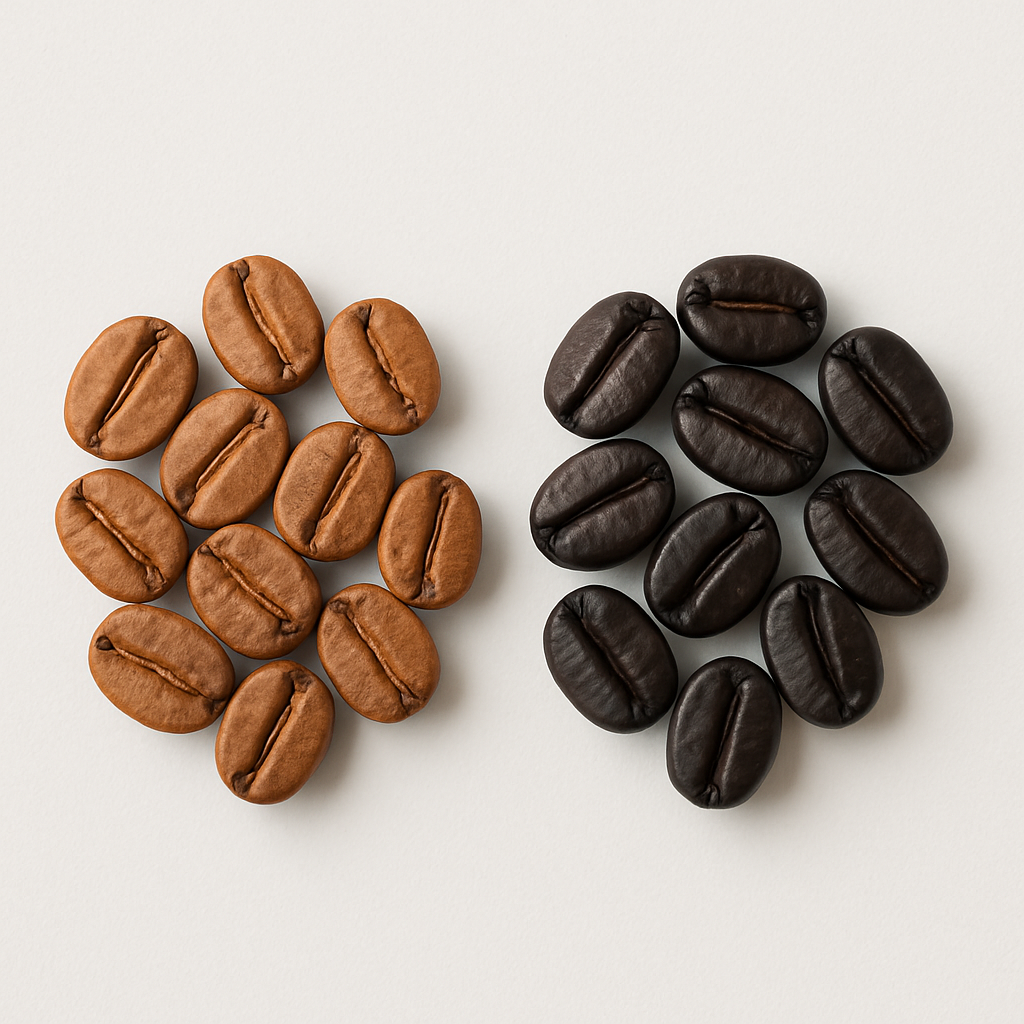

Light Roast vs Dark Roast – Key Differences in Flavour and Caffeine
When it comes to coffee, one of the most common questions I hear is: What’s the difference between light roast and dark roast? These two roast levels can taste like night and day. I’ll walk you through the key differences in flavour, aroma, and even caffeine content between light and dark roast coffee.
Appearance and Roast Profile
The first difference is obvious from the moment you see the beans:
-
Light Roast Beans: Light brown in colour, dry on the surface, and generally smaller in size (since they haven’t expanded as much). They’re roasted to a lower temperature, and dropped shortly after the first crack.
-
Dark Roast Beans: Dark chocolate brown or near-black, often shiny with oils on the surface. These beans are taken well past the first crack, often into the second crack stage of roasting. They expand more, becoming slightly larger and less dense.
From a roasting perspective, light roasts spend less time in the roaster and are exposed to lower heat. Dark roasts endure a longer roast that brings out oils and carbonises more of the bean’s sugars. Visually and physically, they’re quite distinct.
Flavour and Aroma Differences
The flavour profiles of light vs dark roasts are almost opposites:
-
Light Roasts: Expect bright, vibrant flavours. You’ll taste the coffee’s origin – whether it’s the floral notes of an Ethiopian or the nutty sweetness of a Brazilian.
The aroma can be fruity or floral, and the acidity is more pronounced (think of it as a zesty brightness).
There’s a often intense sweetness, and you can pick up complex layers of flavours such as teas, flowers, fruits, or in some cases liquor, candy and herbal notes. -
Dark Roasts: Here the dominant flavours come from the roast itself. You’ll often get bittersweet, smoky, or chocolatey notes.
The unique origin flavours are lost, replaced by deep caramelised sugar, toasted nuts, or even a charred flavour. As the roast gets darker, bitterness increases. The aroma is heavy and robust, reminiscent of toasted bread or cocoa. Acidity is much lower – dark roasts tend to taste smooth, bold, and bitter.In short, dark roasts impart that classic “coffee” taste many people recognise, but light roasts allow one to really recognise and appreciate the individual characteristics of a coffee.
To be honest, dark roasted coffee is mostly to do with tradition. French/Italian roasts have been enjoyed for decades, but those working in speciality coffee don't enjoy dark roasted coffee due to the intense bitterness and the loss of the character of the coffee. Imagine paying lots of money for a Japanese Prime Wagyu Steak, and then eating it well done. Which leads me to another point, you'll often find dark roasting hides the taste of the coffee because, the quality is poor.
Another key difference is the body of the coffee (how heavy or rich it feels on your palate):
-
Light Roast Body: Generally lighter-bodied. Many light roasts have a clean, refreshing finish without a lingering, unpleasant aftertaste. However, you can still find many juicy, thick bodied light roasts. Look out for South/Central American coffees as these tend to fit that profile.
-
Dark Roast Body: Fuller-bodied and heavier. Dark roasts often have a thicker mouthfeel, sometimes even described as oily or syrupy in heft. They tend to leave a lingering, intense aftertaste that can coat the palate.
The darker the roast, the more the coffee’s fibrous structure breaks down, contributing to that heavier mouthfeel. Light roasts, being less developed, retain a crisper, lighter finish.
Caffeine Content – Myth vs Reality
There’s a popular belief that dark roast coffee has more caffeine because it tastes stronger, or conversely, that light roasts have more caffeine because less is “burned off.” The truth is a bit nuanced:
-
By volume (for example, if you measure coffee with a scoop), light roast beans can have slightly more caffeine. This is because light roast beans are denser – a scoop of light roast weighs more and thus contains more caffeine than a scoop of darker beans which are less dense.
-
By weight (if you weigh your coffee in grams), the caffeine difference is minimal. Roasting doesn’t destroy caffeine significantly until extremely high temperatures. A 20g dose of light roast and a 20g dose of dark roast will have nearly the same caffeine. Any difference is negligible in terms of your energy boost.
In essence, roast level isn’t a reliable indicator of caffeine kick. The strong taste of dark roast is often mistaken for “stronger coffee,” but it doesn’t equate to more caffeine – just more roast intensity.
Choosing Between Light and Dark
So, how do you choose? Light roasted coffee can truly be for everyone. If you're not a fan of bright acidity, look for tasting notes of chocolate, nuts and toffee, if you prefer bright, super sweet coffees, look for notes of florals and fruit. Dark roasted coffee is outdated and intensely bitter. If you're a fan of dark roasted, I recommend getting a brazilian natural, light roasted coffee with the tasting notes I've described, and comparing it to your favourite dark roasted coffee. You'll quickly notice the intense, unpleasant bitterness of your soon to be ex-favourite coffee.
Understanding the differences in flavour and caffeine between light and dark roasts can help you make more informed choices about what to brew. Light roasts offer a taste of the coffee’s true character with complex, layered, delicious flavours andaromas, dark roasts are undeniably rich and, a nod to coffee's origins. They still have their place, but the steak cooking terminology rings true.
